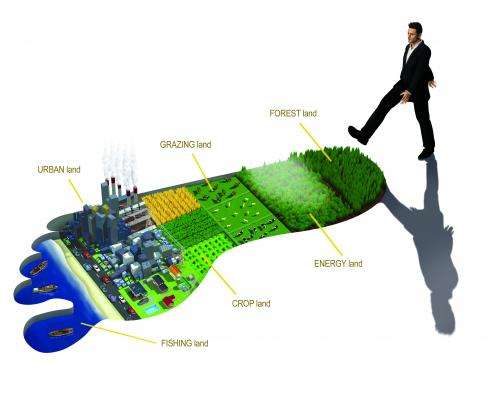What good are footprints?

In "Frontiers in Footprinting," a special feature in the new issue of Yale's Journal of Industrial Ecology, leading voices in the field of industrial ecology provide contrasting viewpoints on the value of footprinting and explore new directions in this still-evolving field.
The notion of environmental "footprinting" as a way to represent the impact of human activity on the planet's environment has become a veritable industry over the last two decades.
Since the concept first gained popularity in the 1990s—when it was introduced by researchers William E. Rees and Mathis Wackernagel—footprinting has been used to explain a range of complicated phenomena as a single metric, spawning carbon footprints, water footprints, and various other indicators to communicate the carrying capacity of Earth.
In "Frontiers in Footprinting," a special feature in the new issue of Yale University's Journal of Industrial Ecology (JIE), leading voices in the field of industrial ecology provide contrasting viewpoints on the value of footprinting and explore new opportunities that this still-evolving field continues to offer.
"Footprinting is a powerful and compelling concept because it summarizes complicated phenomena in a single number," says Reid Lifset, editor-in-chief of JIE. "That is simultaneously its strength and its weakness."
The 12-article feature includes:
- The debut of a new regular column, Footprinting, by Manfred Lenzen of the University of Sydney. In this first column, Lenzen explores opportunities to extend the concept of footprinting through new application areas, a broader scope of repercussions, wider geographic reach and increased opportunities for collaboration using the latest in data analysis and computational technologies.
- Klaus Hubacek and four colleagues propose the use of "teleconnections" to assess how consumption at local levels affects environmental impacts in other locations. In addition, they explore how geodemographics and related forms of "big data" can help calculate environmental footprint estimates based on local consumption.
- Jeroen van den Bergh and Fabio Grazi challenge the merits of ecological footprinting, arguing that the simplification of myriad complex environmental challenges into one metric is "bad economics and bad environmental science." In a stinging critique, they make the case that ecological footprinting offers little beyond the generalization that "we are overexploiting the planet."
- In a response article, Wackernagel, the University of British Columbia researcher who helped pioneer the footprinting concept, insists that ecological footprinting has indeed provided a critical, sound and policy–relevant service by highlighting the mismatches between human demand and the regenerative capacity of ecosystems. (A rejoinder from Van den Bergh and Grazi is also included in the issue.)
- Ali Alsamawi, of the University of Sydney, and two colleagues use employment and income data to determine the social impacts of production, developing a provocative theory of "master-servant" relationships based on how many people a country needs working, both domestically and internationally, to meet its consumption needs versus how many people are working to meet export demands, in addition to their own consumption needs.
- Three articles explore the field of water footprinting. One assesses the lifecycle of fresh- and groundwater associated with copper extraction in Chile; another examines energy vulnerabilities in cities dependent upon water resources from outside the city limits; and another assesses the unintended consequences of changes in crop production in China.
"As this special feature of the Journal of Industrial Ecology makes clear, the concept of footprinting is one that continues to evolve and advance, with implications across a range of disciplines," said Peter Crane, Dean of the Yale School of Forestry & Environmental Studies. "This collection of articles illustrates how developments in industrial ecology improve our ability to quantify and communicate the impact of economic activity on the environment and society."
According to Lifset, the application of new information technologies, the emergence of big data, and visible intellectual rigor and debate indicate the great potential of footprinting.
"By extending footprinting to include social concerns and adding new precision to the examination of the environmental impacts of consumption," Lifset said, "there is potential to offer a more sophisticated assessment of the triple bottom line of sustainability—environmental, economic and social."
More information: Articles in the special feature will be freely downloadable for a limited time at: jie.yale.edu/footprint
Provided by Yale University


















